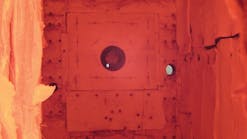"Our boilers had cracked sections twice last year," the facility manager for a school district said. "The consultant says the boilers are too small, they cracked from thermal shock, and we need new boilers. What should we do?"
Analyzing the facility's gas bills allowed me to develop a formula to predict heating load at any outdoor temperature. The formula showed the boilers had 50-percent excess capacity: Two boilers each could carry 3/4 of the load, providing reasonable redundancy. New boilers were not needed for capacity.
That was the easy part. The harder question was why the boiler sections cracked. At the site, I saw that only one of the two boilers had cracked, and the cracks were in sections 5, 6, and 7 of the 18-section boiler. Thermal shock occurs when cold water enters a hot boiler. Water enters a boiler at the back, so thermal shock usually affects the last few sections. With failures occurring in the middle of the boiler, thermal shock was unlikely. On top of that, the way the boilers were piped, flow did not divide evenly between the two boilers. Less "cold" system return water would flow through Boiler 2 than Boiler 1, so Boiler 2 would be less susceptible to thermal shock than Boiler 1. Yet Boiler 2 is the one that cracked. Again, not likely thermal shock.
Then, I saw the boilers had on/off control. Each boiler fired at 5 million Btuh or was off. Five million is a big capacity step. Except on the coldest days, the boilers would bang on and off again and again. So, I had three clues: failures in the middle of the boiler; failure in the boiler with less water flow and, thus, less ability to absorb heat; and frequent cycling at a high firing rate.
Boilers experience cyclic stresses every time a burner starts and stops. Those stresses occur because the boiler structure resists the expansion and contraction that otherwise would occur from temperature change. The higher the firing rate, the greater the stress. Cold return water increases stress because of the greater temperature difference between the fire side of the casting and the inside surface exposed to the water.
Taken together, the clues said thermal fatigue. Fatigue affects materials subjected to cyclic loads. Although classic fatigue failures occur from physical stress, fatigue failures can result from any type of cyclic load, including repeated temperature change.
The solution was easy: Add a low-fire controller to reduce cycling by letting the boiler run at low fire on startup and at light load, jumping up to high fire only at high load.
Kenneth M. Elovitz, PE, Esq.
Energy Economics Inc.
Foxboro, Mass.
Have a "war story" to share? Send it to Executive Editor Scott Arnold at [email protected].








